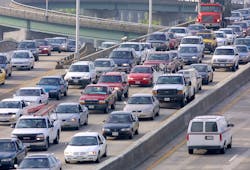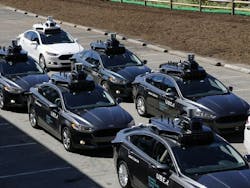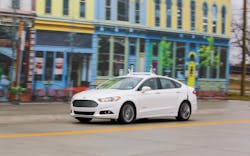Will autonomy actually make traffic congestion worse?
There’s been a lot of discussion lately about the positive and negative impact widespread adoption of autonomous vehicles (AVs) might have on our society – positive in the sense that they’ll reduce crashes and thus improve safety, but negative in terms of the potential for massive job losses among truck drivers.
In a recent blog post, Howard Jennings – managing director of the Mobility Lab – added another concern to the worry list surrounding AVs: could they worsen traffic congestion in our nation?
[That would not be good, especially since traffic congestion is proving to be a giant drain on the trucking industry’s wallet as this story explains.]
“The advent of AVs is fraught with uncertainty, especially when it comes to their impacts on traffic, travel choices, and the broader transportation system,” noted Jennings in his post.
“They offer many potential benefits, but many potential negative impacts, depending in part on how they are deployed,” he added. “While widespread adoption may still be decades away, significant numbers will begin to be on the roads in less than 10 years, according to manufacturers and other observers. Ultimately, many expect them to have major transformational effects on our transportation systems and built environment.”
Jennings said the key is to consider the impact of AVs on our roads as a potential transportation demand management (TDM) problem – and preparing TDM-type policies to address them.
“When it comes to the most pressing issues to be addressed in the deployment of AVs, safety and infrastructure do not necessarily top the list of urgent needs,” he explained.
“Federal and state policies are already looking to address these. Since safety is one of the major motivations for adopting autonomous technologies, and a top concern for skeptical consumers, agencies and automakers are prioritizing it,” Jennings stressed. “Either they will be made safe, or they won’t be on the roads.”
Yet the exact impacts to communities and traffic systems from broad deployment of AVs are “poorly understood” form where he sits – and could potentially create new problems.“Ironically, the efficiency of AVs has long been touted as a solution to traffic, but new research is beginning to suggest that AVs will, in fact, generate more of it,” Jennings emphasized.
“Simply put, there is no guarantee the traffic effects of AVs will be handled. It is entirely possible that they will spread widely and, without adequate policies, many places may never manage their impacts,” he noted. “We never fully anticipated the impacts of conventional cars as they were being developed, and we have been living with many unintended consequences in … our communities for the last 100 years.”
What we do know, Jennings pointed out, is that AVs will create an “unprecedented convenience” in driving.
“By eliminating most of the hassles of driving, such as parking and lost productivity time, AVs will induce not only more trips, but longer ones,” he noted. “Additionally, AVs waiting to pick up new riders will add ‘deadheading’ miles.”
Yet in terms of traffic flow, the only thing worse than a single-occupant vehicle is a zero-occupant vehicle, Jennings explained.
“Placed all together, this suggests they will almost certainly increase vehicle-miles traveled (VMT), energy use, and emissions,” he emphasized. “Those impacts might be locked in by further sprawl and other shifts toward less efficient land-use patterns.”
AVs, according to a 2015 Urban Mobility study by the International Transit Forum and Corporate Partnership Board, are expected to generate up to 35% more VMT when compared to manually-driven conventional cAnd while AVs in a shared “fleet” would generate less VMT, AVs in “taxi mode” carrying single passengers all the way to their destinations would create 90% more VMT than typical taxies.
“To avoid the worst of these traffic scenarios, policy needs to be deployed with an eye towards minimizing the added miles and the demand for situations involving zero-occupant vehicles,” Jennings stressed.
When it comes down to it, the demand guiding AV impacts is a hybrid of a person’s choice, as in their decision to initiate the trip, and the self-driving technology itself, he explained.
“In short, policymakers should adapt TDM principles to autonomous vehicles, using a mix of incentives and disincentives to guide choices,” Jennings noted.
To that end, he made a few suggestions:
- Policies should always seek to encourage AVs that move more people in fewer vehicles.
- Incentives should be in place to guide people and employers towards more efficient choices. The deployment and pricing models offered by automotive and tech companies should be structured to make shared AVs, not personal AVs, the model of choice.
- AVs that feed into transit systems create the lowest amount of VMT and, in many cases, might expand the reach and usefulness of those transit systems. For example, autonomous taxis used as a “connector” to public transit networks only produce 6% more VMT compared to “typical” taxis.
- Policymakers should seek to create pricing policies to head-off the traffic-inducing effects of personal AVs. For example, a VMT fee would discourage longer trips in general, while a higher single-occupant fee would encourage AV riders to share rides. A zero-occupant vehicle [ZOV] charge, addressing the miles added by AVs circling between pick-ups or headed home to park, would warrant the highest VMT fee.
“The ‘ZOV’ miles represent an entirely new [traffic] congestion danger, as they may be generated from the mere convenience of AV owners asking their cars to circle while they pick up groceries, but can add up to significant traffic consequences,” Jennings stressed.
Just some of things we need to keep in mind as AVs begin to deploy on our roadways.


